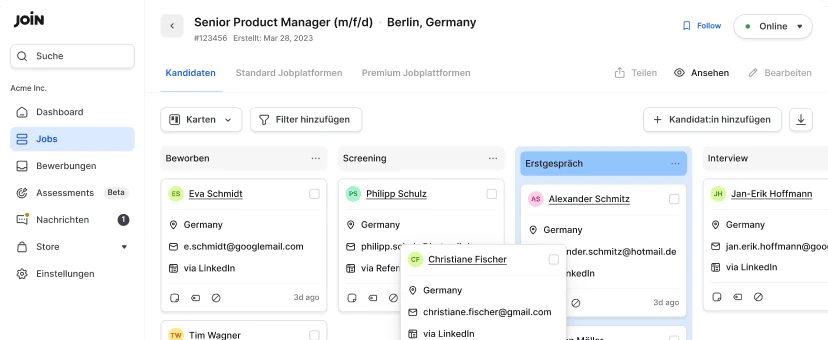5 candidate screening best practices for an effective, automated process
Table of contents
Candidate screening should be quick and efficient, so you don’t waste time. After all, if you take too long, the candidate might drop out of the process. But if you don’t screen a candidate thoroughly enough, you risk investing time and effort in interviewing someone clearly unqualified.
Table of contents
The solution? Create an effective, (semi-) automated process that balances speed and efficiency with sufficient thoroughness. And this doesn’t have to be difficult, nor require expensive recruitment software.
Below, we walk you through some simple methods and best practices to improve your candidate screening process. From what you can already do before the actual screening, to automating certain steps to create a faster process. So read on to learn how to quickly screen applicants and find the right hire!
What is candidate screening?
The screening process is a part of the wider hiring process. It refers to the process of reviewing candidate applications and selecting (also called shortlisting) who will be invited to the next step. The next step generally marks the beginning of the interview process.
Screening can be done either manually or (semi-) automatically. In some companies, the process only includes reviewing candidate applications and the accompanying documents, such as the candidate’s CV.
In other cases, the process further includes a phone screening interview. This is a short phone or video call between the recruiter and the candidate to check the applicant’s suitability, before inviting them to their first interview with the hiring manager.
Candidate screening is an important part of the hiring process, as it helps recruiters sift through the (sometimes hundreds of) resumes and applications to ensure they only interview potential hires.
Common issues when screening candidates
Reviewing candidate CVs and reading their cover letters isn’t difficult if a job opening only received five applications. But what if it’s five hundred?
Reading through and checking everything yourself will take days of your time. And that’s something you don’t have, as in today’s volatile labour climate, your time to hire needs to be as quick as can be. And that’s not the only struggle when it comes to effective screening.
Example candidate screening issues to consider:
- How to make it quick yet thorough enough, so you don’t risk interviewing someone unsuitable or unqualified, potentially costing you even more precious time.
- How to avoid bias seeping into your process, as you try to quickly select candidates based on potentially non-inclusive characteristics such as educational background or years of experience.
- How to ensure your screening methods are ethical and legally compliant.
Let’s find out below how you can avoid these (and similar) points.
5 candidate screening best practices
Below are a few simple steps and methods that you can take to ensure your candidate screening is fast, fair, and (or at least as much as possible) foolproof.
1. Start with pre-screening methods
See it as the screening before the screening. Because the steps you take before the first applications come in will influence the applications you receive.
Here are some pre-screening steps to consider:
- Perfect your career page to ensure your company meets candidate expectations, finding the balance between selling your company while also not overselling it
- Optimise your job ad, so you are asking for the right skills and experience for the role
- Use the right job boards to attract the right candidates, whether it’s generalist job boards for the largest reach or niche job boards to find specialised skill sets
- Include screening questions that candidates have to answer while applying for the position to already gather the most important information (for examples, see point 3 below)
2. Ensure your process is legal and ethical
When adding such screening questions to your application process—and we highly recommend you do so—you should ensure that you only ask for information relevant to the role. Furthermore, the information you request should not open the way for discrimination or bias to enter your process. This can not only be unethical, but even illegal.
For example, don’t ask candidate screening questions such as “are you planning to have children in the next few years” or “have you been diagnosed with a disability of any sort, such as autism”. Asking such questions can lead to biased hiring decisions. See point 4 below for more information on avoiding bias.
Moreover, although for some professions background checks might be necessary or even a legal requirement (for example when the candidate will be working with children), this is typically not the case. For instance, if you’re hiring a software engineer, chances are you shouldn’t perform any background checks.
3. Ask the right candidate screening questions (10 examples)
We’ve mentioned what questions you shouldn’t ask, but so what can you ask instead?
If you use dedicated recruitment software like JOIN to handle your hiring flow, you can already easily add (or delete) pre-written screening questions to your application form to speed up the process. Do you need more inspiration?
Here are 10 example candidate screening questions:
- When are you available to start working with us?
- What is your expected yearly compensation range?
- What is your skill level in [insert name of tool]?
- Are you currently legally permitted to work in [insert location]?
- Do you have a valid [insert type] licence?
- What is your current proficiency in [insert language]?
- Do you currently live in [insert city]?
- Do you have a [insert level] degree in the field of [insert field]?
- How many years of experience do you have in [insert role or skill]?
- Are you open to working on weekends?
By having candidates fill out these questions, you straight away find out if there are any clear red flags or non-negotiable conditions. Reviewing the answers is quick, but it can save you a lot of time and resources scheduling interviews with unsuitable candidates.
4. Automate and avoid bias
Effective candidate screening needs to be fast and efficient, especially in the current climate of global labour shortages. That’s why it’s important to try and automate as much of the recruitment process as possible.
This is where using an Applicant Tracking System (ATS), like JOIN, can help. With an ATS, you can not only easily create the application form inside the tool, but you can automatically qualify or disqualify candidates based on their answers to some questions (generally the ones asking for the basic or must-have requirements).
You can even have the tool trigger automated messages to applicants as soon as they are disqualified in your system.

Moreover, an added bonus of automating steps like this is that it can also help reduce the chance of bias entering your selection process in HRM.
Because as soon as an employee is tasked with reviewing applications, the chance of (unconscious) biases influencing decision-making increases.
Want to know more about how to reduce bias in your hiring process? Then check out these suggested reads:
5. Centralise all applications with candidate screening software
Our fifth tip for optimising the way you screen applicants is to centralise all applications you receive within one platform. This way, you can easily and efficiently review all incoming applications, regardless of the job board or platform it was originally submitted to.
JOIN allows you to collect applications from dozens of job boards and smoothly manage and communicate with candidates inside one single tool.
With everything centralised, you can quickly screen candidates, their CVs, and their cover letters. Once you qualify or disqualify a candidate, simply move them to the next step in the candidate pipeline.
The secret to efficient candidate screening
By following these five tips you can start building a streamlined screening process that allows you to move candidates much more quickly through your recruitment funnel.
This, in turn, can help reduce your time to hire and improve your chances of attracting and hiring the best talent for your business. Curious to improve your recruitment process even more?
Then find out what to do after you’ve finished screening, with this article on how to conduct a candidate interview.
Frans Lelivelt
Frans is JOIN's multilingual Senior Content Manager. His main topic of interest in the recruitment space is DEI and how companies can reduce their (unconscious) biases to make the world of work a fairer, kinder place for everyone. Outside of work, he tries to do the same for animals, spending much of his spare time in the kitchen preparing plant-based feasts.
![How recruitment automation can benefit your hiring process [tips and tools]](https://cdn-public-assets.join.com/2022/07/33bf324f-stephen-dawson-qwtcej5clys-unsplash_1_1920x1280.jpeg)

